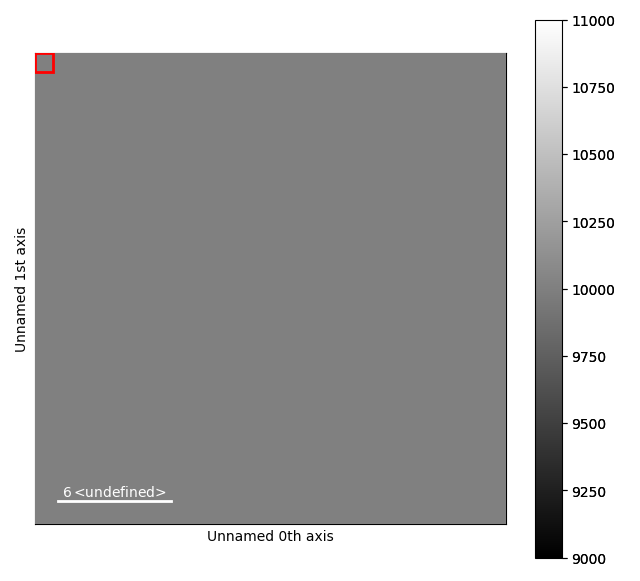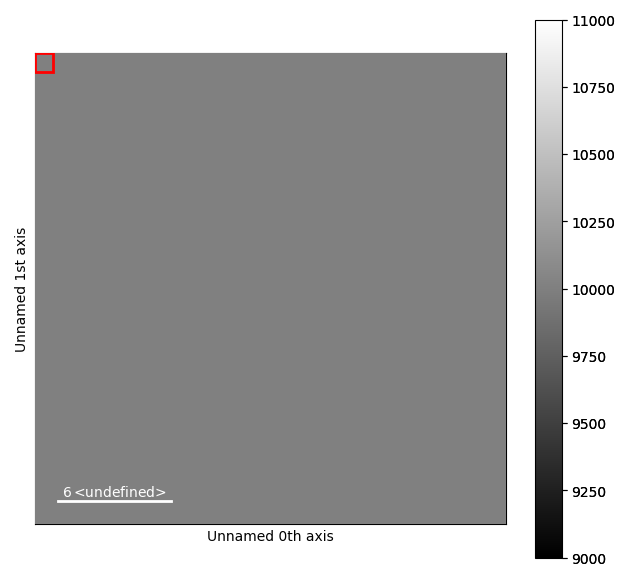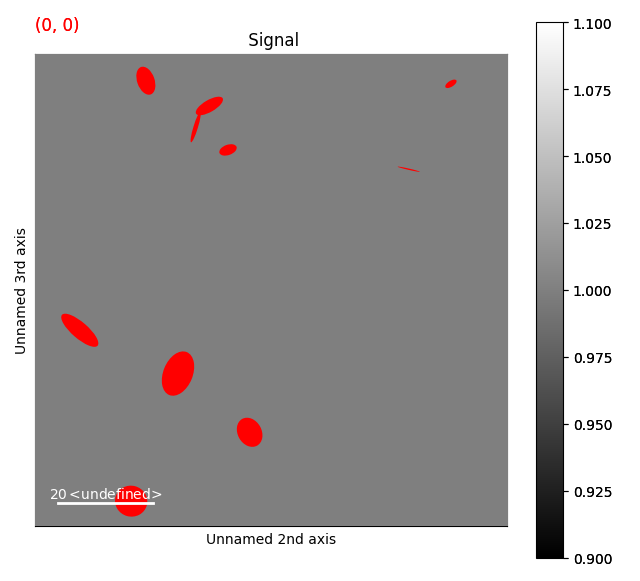Note
Go to the end to download the full example code.
Ellipse markers#
Create a signal
import hyperspy.api as hs
import numpy as np
# Create a Signal2D with 2 navigation dimensions
rng = np.random.default_rng(0)
data = np.ones((25, 25, 100, 100))
s = hs.signals.Signal2D(data)
This first example shows how to draw static ellipses
# Define the position of the ellipses
offsets = rng.random((10, 2)) * 100
m = hs.plot.markers.Ellipses(
widths=(8,),
heights=(10,),
angles=(45,),
offsets=offsets,
facecolor="red",
)
s.plot()
s.add_marker(m)
/opt/hostedtoolcache/Python/3.12.12/x64/lib/python3.12/site-packages/rsciio/utils/rgb_tools.py:62: VisibleDeprecationWarning: The module `rsciio.utils.rgb_tools` has been renamed to `rsciio.utils.rgb` and it will be removed in version 1.0.
warnings.warn(
/opt/hostedtoolcache/Python/3.12.12/x64/lib/python3.12/site-packages/rsciio/utils/rgb_tools.py:62: VisibleDeprecationWarning: The module `rsciio.utils.rgb_tools` has been renamed to `rsciio.utils.rgb` and it will be removed in version 1.0.
warnings.warn(
/opt/hostedtoolcache/Python/3.12.12/x64/lib/python3.12/site-packages/rsciio/utils/rgb_tools.py:62: VisibleDeprecationWarning: The module `rsciio.utils.rgb_tools` has been renamed to `rsciio.utils.rgb` and it will be removed in version 1.0.
warnings.warn(
Dynamic Ellipse Markers#
This first example shows how to draw dynamic ellipses, whose position, widths heights and angles depends on the navigation coordinates
s2 = hs.signals.Signal2D(data)
widths = np.empty(s.axes_manager.navigation_shape, dtype=object)
heights = np.empty(s.axes_manager.navigation_shape, dtype=object)
angles = np.empty(s.axes_manager.navigation_shape, dtype=object)
offsets = np.empty(s.axes_manager.navigation_shape, dtype=object)
for index in np.ndindex(offsets.shape):
widths[index] = rng.random((10, )) * 10
heights[index] = rng.random((10, )) * 7
angles[index] = rng.random((10, )) * 180
offsets[index] = rng.random((10, 2)) * 100
m = hs.plot.markers.Ellipses(
widths=widths,
heights=heights,
angles=angles,
offsets=offsets,
facecolor="red",
)
s2.plot()
s2.add_marker(m)
/opt/hostedtoolcache/Python/3.12.12/x64/lib/python3.12/site-packages/rsciio/utils/rgb_tools.py:62: VisibleDeprecationWarning: The module `rsciio.utils.rgb_tools` has been renamed to `rsciio.utils.rgb` and it will be removed in version 1.0.
warnings.warn(
/opt/hostedtoolcache/Python/3.12.12/x64/lib/python3.12/site-packages/rsciio/utils/rgb_tools.py:62: VisibleDeprecationWarning: The module `rsciio.utils.rgb_tools` has been renamed to `rsciio.utils.rgb` and it will be removed in version 1.0.
warnings.warn(
/opt/hostedtoolcache/Python/3.12.12/x64/lib/python3.12/site-packages/rsciio/utils/rgb_tools.py:62: VisibleDeprecationWarning: The module `rsciio.utils.rgb_tools` has been renamed to `rsciio.utils.rgb` and it will be removed in version 1.0.
warnings.warn(
sphinx_gallery_thumbnail_number = 2
Total running time of the script: (0 minutes 1.800 seconds)




